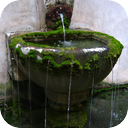(short preview of full seamless looping track)
Small Waterfall Fountain
This product is not available in the selected currency.
In Stock
Backordered
Out of Stock
Description
The afternoon nap, in both ancient and modern times, should always be accompanied by the relaxing resonance of summer's water slipping off cold stone to splash and play in the sunlight. Before you know it, your head is slowly dropping back and your eyes easing into a semiconscious state as your shoulders relax into a puddle of mushy muscle, and the old lines of worry on your face unfurl and finally free themselves to act like they have alway wanted to. Fountains were originally purely functional, connected to springs or aqueducts and used to provide drinking water and water for bathing and washing to the residents of cities, towns and villages. Until the late 19th century most fountains operated by gravity, and needed a source of water higher than the fountain, such as a reservoir or aqueduct, to make the water flow or jet into the air. In addition to providing drinking water, fountains were used for decoration and to celebrate their builders. Roman fountains were decorated with bronze or stone masks of animals or heroes. In the Middle Ages, Moorish and Muslim garden designers used fountains to create miniature versions of the gardens of paradise. King Louis XIV of France used fountains in the Gardens of Versailles to illustrate his power over nature. The baroque decorative fountains of Rome in the 17th and 18th centuries marked the arrival point of restored Roman aqueducts and glorified the Popes who built them. By the end of the 19th century, as indoor plumbing became the main source of drinking water, urban fountains became purely decorative. Mechanical pumps replaced gravity and allowed fountains to recycle water and to force it high into the air.
Opps
Sorry, it looks like some products are not available in selected quantity.



